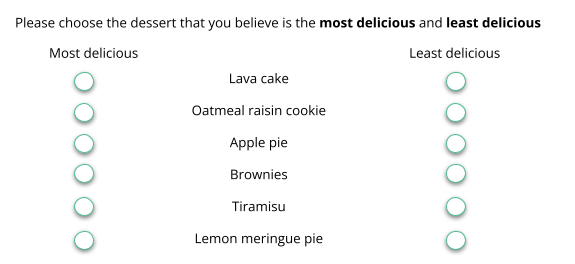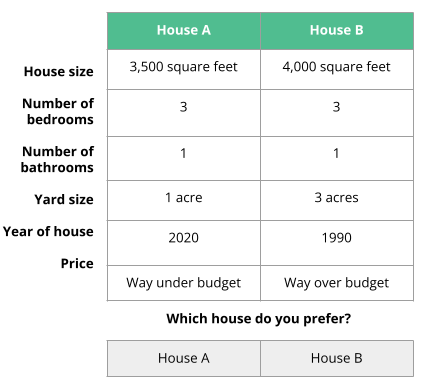MaxDiff analysis and conjoint analysis are two popular research methods used in market research to understand customer preferences and behavior. Although both methods aim to provide insights into consumer preferences, they differ in their approach, application, and the research questions they address.
This article provides an overview of the differences between the two most common types of discrete choice experiments:
- MaxDiff analysis: A traditional, preference-based analysis.
- Conjoint analysis: A full-profile and choice-based analysis.
Uncovering Consumer Preferences with MaxDiff Analysis
MaxDiff analysis, also known as maximum difference scaling and best-worst scaling, is a survey method that asks respondents to compare and rate different attributes of a product. Over the course of multiple tasks, survey respondents are presented with sets of attributes, usually ranging from three to five, and asked to choose the most important and least important attributes in each set. The data are used in a statistical model to calculate the relative importance that each attribute contributes to overall preference of the product, which can be used to inform a product development roadmap, pricing scheme, and/or marketing strategies.
MaxDiff analysis can provide a variety of insights into consumer preferences, including:
- The magnitude of the most and least important attributes helps brand managers focus on the attributes that contribute the most to consumer preference and ignore those that don’t.
- The relative importance of each attribute reveals how consumers prioritize attributes, which can be useful in determining which attributes to focus on when developing a product or service.
- The impact of attribute combinations: MaxDiff analysis can show how different combinations of attributes affect consumer preferences.
MaxDiff analyses are easy to administer in most standard survey softwares, as they require respondents to choose between a limited set of attributes in each question and can be analyzed quickly; however, they may not capture the full spectrum of consumer preferences, as respondents are limited to evaluating only one element of a product. If you want to evaluate multiple elements of a product, then a conjoint analysis is the method you’re looking for.
Uncovering Consumer Preferences with Conjoint Analysis
Conjoint experiments are another type of discrete choice experiment and used to evaluate the preferences for multiple attributes of a product such as price, quality, and design type. The data gathered from conjoint experiments are used to calculate the relative importance of different attributes that drive consumer preference.
Conjoint analysis can provide a variety of insights into consumer preferences, including:
- The most important attributes that drive preference. Is it all about the price? Or the quality? A conjoint tells you how much an overall attribute matters to consumers, a product, or a service.
- The levels within an attribute that drive preference levels. If price is what drives preferences, then what price point is optimal? If it’s color, which color?
- The willingness to pay for a product combination. To find the optimal price point, conjoints can determine what the tradeoff is between revenue and market share at various price points.
A conjoint analysis is more complex than a MaxDiff analysis, but provides much more intelligence on the drivers of consumer preference.
Differences Between MaxDiff Analysis and Conjoint Analysis
MaxDiff analysis and conjoint analysis differ in several ways:
Research questions
MaxDiff analysis is best used for identifying the most and least important attributes of a product and how consumers prioritize them. It helps answer questions such as:
- What are the most important attributes to consumers when making a purchase decision?
- How do consumers rank different attributes in terms of importance?
- How do consumers make trade-offs between different attributes when making purchase decisions?
- Are there segments of consumers with different preferences?
Conjoint analysis is best used for identifying the most important attributes, and which level within the attribute drives preference. It helps answer questions such as:
- What are the most important attributes to consumers when making a purchase decision?
- What levels are most preferred?
- How much are consumers willing to pay for different levels of each attribute?
- What is the ideal combination of attribute levels to maximize preference?
Approach
MaxDiff analysis asks respondents to choose the most and least important attributes in a set, while conjoint analysis asks respondents to evaluate hypothetical product or service profiles.
For the MaxDiff, respondents choose their most and least preferred items across a series of choice tasks. Each choice task contains a random subset of the total items the researcher is testing. For instance, if a researcher wants to know the most and least preferred desserts from a list of 15, respondents would only see a random set of six desserts in each choice task. A typical choice task looks like the following:

Conjoints, on the other hand, typically ask respondents to evaluate a combination of attributes and levels simultaneously. Levels are nested within attributes such that red, green, and blue are levels within the attribute color. In a standard choice-based conjoint, a single level is randomly displayed in each attribute being tested. Similar to the MaxDiff, respondents will complete a series of choice tasks. Unlike in a MaxDiff, where respondents choose their most and least preferred items, respondents are only asked to choose the combination of levels that is most appealing to them in each choice task. Most often, respondents are asked to select between two or three combinations of levels as shown below:

Summary of Differences Between Discrete Choice Experiments
In summary, MaxDiff analysis and conjoint analysis are two popular research methods used in market research to understand customer preferences. Both methods provide insights into preferences but differ in their approach, application, and the scope of research questions they address. MaxDiff is used to identify the most and least important attributes and how consumers prioritize them, while conjoint analysis is used to identify the most important attributes, levels within attributes, and how much consumers are willing to pay for different attribute levels.
This blog post provides a broad overview of the differences between the two discrete choice methods but is by no means exhaustive. There are a number of different kinds of MaxDiffs and conjoints that can be used to answer a variety of research questions and differ slightly in their output compared to what has been described.
If you’re interested in more ways discrete choice experiments can help with your product design roadmap, or if you want assistance deciding between the two, you can reach out to us here.











